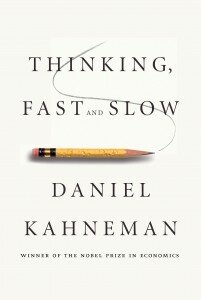Posts Tagged ‘brand’
Loss aversion looms large in branding
Not long ago I believed sustainable business, renewable energy and the socially responsible consumer were on the verge of going mainstream. I know they will get there eventually, but that day now seems farther away.
Those of us impatient for change — in our organizations, among our customers, within society — would do well to sit with this fact: People are more motivated to avoid losses than to achieve gains. How much more? About twice as motivated.
This is just one of many thought-provoking research findings explained by preeminent psychologist Daniel Kahneman in his latest book, “Thinking, Fast and Slow.”
This is my second post exploring what some of Kahneman’s findings could hold for brands and the organizations and leaders managing them. Earlier I looked at the distinction between plausibility and probability in the brand stories we tell. Here I’m interested in what humans’ deep-seated aversion to loss means for purveyors of change. (more…)
Is your brand story merely plausible?
Some years ago I led the public relations launch of a next-generation “bet your company” software platform for my employer at the time. The product promised to transform an industry and ensure the business retained its star status. Those of us charged with the product marketing did a fabulous job of storytelling. We had the national trade media eating out of our palms, giving us positive, prominent coverage in one publication after another.
But there was one small problem: Our firm never delivered the product — at least not nearly as advertised.
We had sold an incredible story, not an incredible product.
Today, I am looking back at that experience through the lens of one of the most provocative books I have read in years: “Thinking , Fast and Slow” by Daniel Kahneman, winner of the 2002 Nobel Prize in Economic Sciences. Kahneman is actually a psychologist but his work around decision making challenged the prevailing rational model of judgment in economics. He is professor emeritus at Princeton University. (more…)
, Fast and Slow” by Daniel Kahneman, winner of the 2002 Nobel Prize in Economic Sciences. Kahneman is actually a psychologist but his work around decision making challenged the prevailing rational model of judgment in economics. He is professor emeritus at Princeton University. (more…)
Branding lessons from an old hometown
Two weeks ago I returned to my old hometown in Minnesota for the first time in 18 years. And I still can’t shake the obvious: change is constant. Whether we like it or are prepared for it or not.
I could only identify two stores along the three-block downtown that were there in my childhood. Most of the businesses appeared to be on life support. Further south from downtown a once modest commercial stretch reminded me of an abandoned cowboy town. Only the tumbleweed was missing. My high school had been leveled and rebuilt on the north edge of town. My parent’s last and once-proud home, across from the school, stood lifeless. And the downtown store my dad started in 1948 and sold in 1980 is teetering on the verge of going out of business. Perhaps the hardest change of all to swallow.
Little about my hometown seemed as I remembered it, except the pretty lake at its center. It hadn’t died as a community. It only felt that way. So much that anchored my memories of growing up there has now disappeared, if not physically, then emotionally. I told my wife the last morning we were there, I’m not sure I will ever have the need or desire to return. (more…)
5 ways brands can engage on climate change
2010 tied 2005 as the hottest year on record, according to reports last week. The news came as flood waters overwhelmed Queensland, Australia and mudslides killed hundreds in southeast Brazil. The natural disasters were made worse by global warming, scientists told ABC News.
Meanwhile, a new poll shows only 40% of Americans believe global warming is caused by human activity. And New York Times environmental blogger Andy Revkin said in 2010 “global warming, the greatest story rarely told, had reverted to its near perpetual position on the far back shelf of the public consciousness — if not back in the freezer.”
Is that how it is for you? Is climate change even on your radar screen as a business? And if it is, are you doing something about it? Or are you treating it like some harmless object along the distant horizon?
What your brand can do
I won’t make an argument for why you or your business should care about climate change. I’ll leave that to authors like Bill McKibben, whose 2010 book “Eaarth” is an unsparing description of a world already scarred by global warming and a guide to how we must now live in it.
What I would offer are five ways your business brand can engage stakeholders on climate change. After all, a large minority of Americans believes humans are causing global warming and increasing numbers of customers are holding business accountable. On the opportunity side, brand differentiation around climate change is there for the taking in many markets.
- Brand as promise: You can’t waffle on climate change. Choose to believe the scientific evidence and climate scientists like this one who states unequivocally, ”We’re observing the climate changing – it’s happening, it’s real, it’s a fact.” Take a stand. Let your stakeholders know your business cares deeply about the trajectory of the world’s climate. Then show them what you’re doing about it through your products, services, operations and culture.
- Brand as meaning: Customers, employees and, indeed, all stakeholders are in constant search for meaning. That’s life. Connect what you’re doing on climate change to what matters to your stakeholders. And what matters to most of us is that we and those we care about achieve happiness and avoid suffering. The climate is now on a very unhappy path. Be an example for a different way forward.
- Brand as emotion: We all experience basic emotions such as joy, love, anger, sadness, surprise and fear. For many of us, the thought of climate change overwhelms us and triggers undesirable emotions. How much more desirable is a brand that taps into the joy and satisfaction in caring for our planet and its current and future inhabitants?
- Brand as story: Humans connect through stories. It’s how we entertain, educate, preserve our cultures and instill values. Your brand is a story. Place it within the Mother of All 21st Century Stories — climate change — and watch as new, meaningful and emotional connections get made.
- Brand as experience: No matter what we tell others about our brands, what determines their fates are the experiences others have of them. When someone interacts with your business or product, they experience your brand as a promise kept or a promise broken. Promise to be on the right side of climate change and then give others the experience of standing with you — and you with them — in creating a world hospitable to all.
Imagining the ‘Sustainable Communicator’
Based on the scale of green marketing we see across all media today, you’d think the practice of sustainability is spreading like wildfire throughout business. And you’d be wrong.
I was reminded of the green vs. sustainability disparity as I was preparing a talk I gave last week to the Communicators Conference in Portland, Ore. In the talk I outlined a vision for what I called the “Sustainable Communicator.”  If this vision came to pass today, I believe we’d see an immediate ratcheting back on the practice of green marketing and a spike in the practice of sustainability.
If this vision came to pass today, I believe we’d see an immediate ratcheting back on the practice of green marketing and a spike in the practice of sustainability.
Let me explain.
First, consider these two studies from 2009:
- In its study entitled “The Road Not Yet Taken,” the Sustainable Enterprise Institute reviewed the public information disclosed by companies in the Russell 1000 Index and concluded: “evidence of any broad spectrum adoption of sustainable business practices is not to be found.”
- The Boston Consulting Group and MIT Sloan Management Review surveyed 2,000 business leaders worldwide as part of their study called “The Business of Sustainability.” The authors reported “a material gap between intent and action at most companies” they examined.
Which begs the question, if business is so slow to embrace sustainability, how can there be so much green marketing? I believe the explanation is this: Sustainability and green are two different concepts. They are not interchangeable. As The Natural Step Network tells us in their workshops, green is focused on details, tactics, environment and “less bad.” Sustainability is focused on whole systems, strategy, triple bottom line (not just the environment) and aligning with nature’s cyclical processes.
Retire green marketing
If I had my way, I’d retire green marketing, as I argued in a previous post. Green marketing in business is first and foremost product marketing. And as we know, you don’t have to be a sustainable business to produce a “green” product.
As the studies above indicate, businesses that adhere to the principles of sustainability and operate from a triple-bottom-line (people, planet, profit) philosophy are uncommon. That means the majority of “green” products are produced, marketed and/or sold by companies that fall far short of the sustainability ideal.
I’m not opposed to green products. We need more of them. But relying on otherwise brown companies to produce green products is at best a “less bad” situation (and clearly the primary reason for greenwashing). If we are to solve the pressing social and environmental issues of our time — clean water, peak oil, over-consumption, income inequity, population growth, climate change — we need businesses fully on board with sustainability.
Fusing brand, culture, sustainability
And here’s where the Sustainable Communicator comes in. This mythical professional fuses the practices of branding, culture change and sustainability into something completely new.
The Sustainable Communicator is a result of a fundamental shift in focus and responsibility:
- from marketing green products to building sustainable businesses
- from creating brand image to living your brand
- from specialist in communications to leader in sustainability, organizational development and branding
Yes, the Sustainable Communicator remains an expert in communications. That goes without saying. She is also a leader in sustainability, triple-bottom-line management, culture change and collaboration.
I admit this is a tall order and unrealistic in the short term. But if business is going to be truly sustainable, it needs new leaders to emerge in all disciplines, including communications. Because we know there’s a significant gap between what business intends to do and what it’s actually doing in the areas of social and environmental responsibility.
The need to close this gap is the impetus behind my firm’s recent formation of the Sustainable Branding Collaborative and 4D Branding process.
Closing the intent vs. action gap
Communications professionals have a major role to play here. We can’t continue green marketing and pretend the gap doesn’t exist. The buck stops with us, as storytellers, to only share what we know to be true and to accurately reflect where our companies are along the path of sustainability.
But storytelling alone is too passive, too removed from the ultimate need of businesses to move farther and faster toward become truly sustainable. The Sustainable Communicator is more than a storyteller. She’s a hands-on leader in transforming business. And it’s in that experience she recognizes green marketing is a thing of the past.





